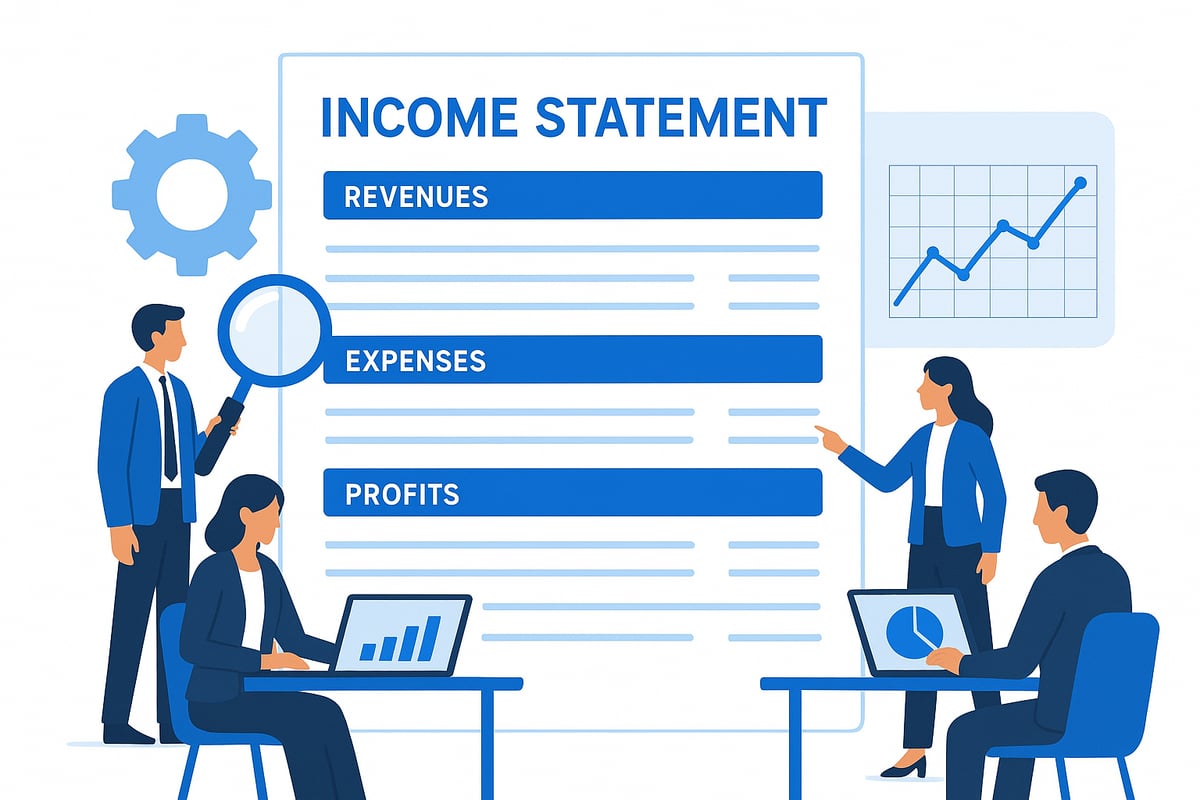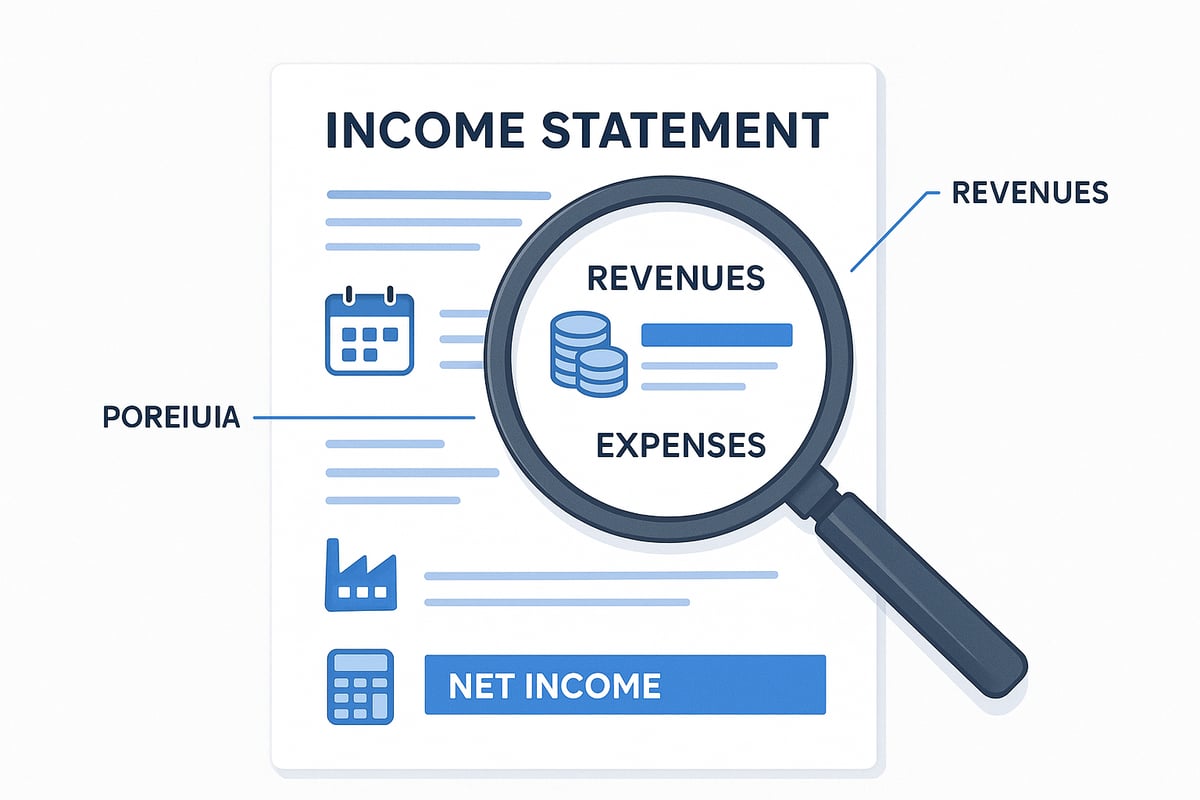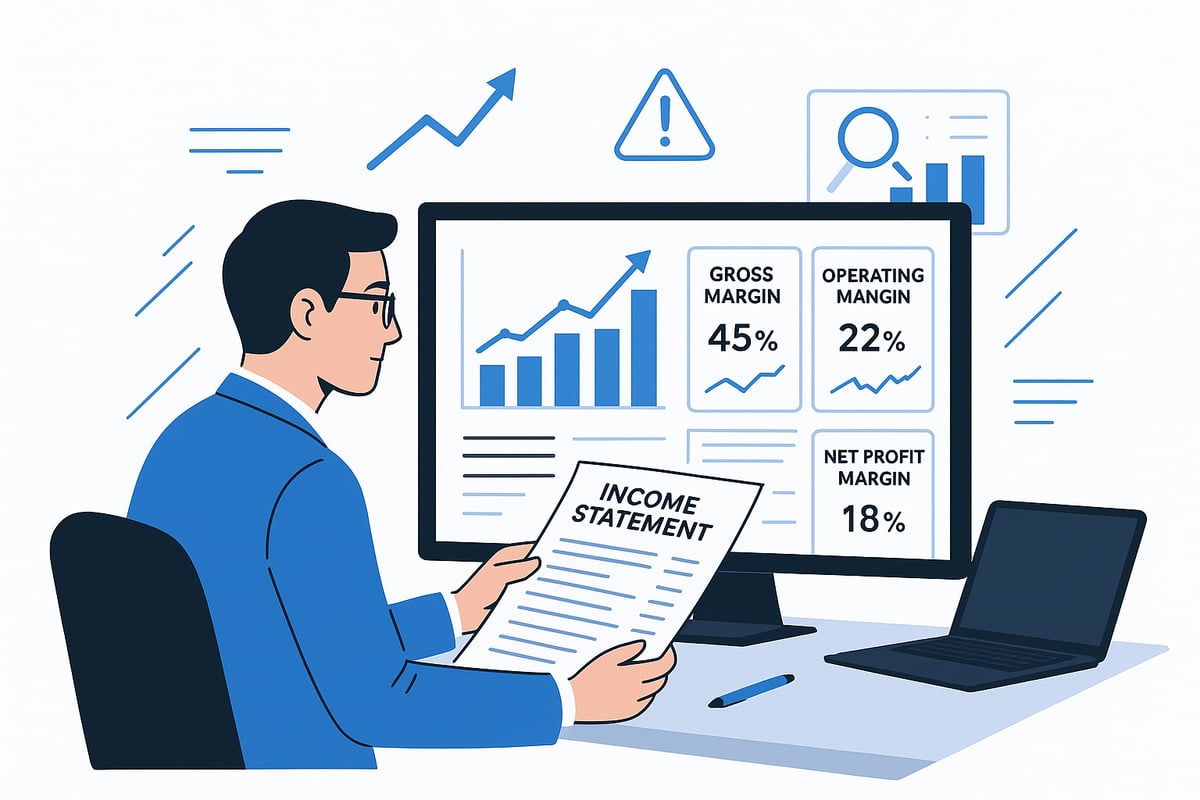Income Statement Guide: Master Your Finances in 2025
Ready to take real control of your financial future in 2025? Whether you’re managing a business, investing, or aiming for personal financial growth, mastering the income statement is your key to clarity and confidence. This guide will walk you step by step through reading, analyzing, and using income statements for smarter decisions in 2025. Discover the basics, learn to break down each section, avoid common mistakes, and unlock actionable strategies that put you ahead. Let’s empower your finances by making the income statement work for you.
Understanding the Income Statement: Foundations for 2025
Mastering the income statement is essential for anyone focused on financial growth in 2025. Whether you are a business owner, investor, or looking to manage personal finances, understanding this document is a foundational skill. The income statement offers a window into a company’s operations, revealing how money is made and spent over time.

What Is an Income Statement?
An income statement is a core financial report that summarizes a company’s revenues, expenses, and profits over a defined period, such as a quarter or year. It serves as a performance snapshot, showing whether a business is generating profit or incurring loss.
Unlike a balance sheet, which details assets and liabilities at a specific date, or a cash flow statement, which tracks the movement of cash, the income statement focuses on operational effectiveness. This statement is crucial for businesses, investors, and even individuals who want to track financial progress.
For example, Walmart’s Q1 2025 income statement reported over $165 billion in revenue. Such figures give stakeholders confidence and context for decision-making.
Key Components Explained
The income statement is structured into several main sections, each playing a vital role:
- Revenues: Total income from sales and services.
- Cost of Goods Sold (COGS): Direct costs to produce goods sold.
- Gross Profit: Revenues minus COGS, showing core profitability.
- Operating Expenses: Includes selling, general, and administrative (SG&A) costs.
- Operating Income: Earnings before interest and taxes, a measure of business efficiency.
- Interest and Taxes: Costs related to financing and government obligations.
- Net Income: The final profit after all expenses, a key figure for shareholders.
For instance, Walmart’s Q1 2025 operating income was $7.1 billion, while SG&A expenses reached $34.1 billion. Understanding terms like “cost of sales,” “SG&A,” and “net income per share” is vital, as each affects the overall profitability. To see these figures in context, review the Walmart Q1 FY25 Earnings Release.
Each component reveals how efficiently a company manages resources and generates profit.
Why Income Statements Matter in 2025
In 2025, the importance of the income statement is heightened by economic uncertainty and regulatory shifts. Businesses rely on it to steer strategy, control costs, and plan for future growth.
Investors use income statements to evaluate profitability and compare companies. Entrepreneurs and employees look at trends in revenue and expenses to gauge performance. For example, recent data highlights the value of effective expense management and how steady revenue growth supports long-term stability.
This statement also plays a key role in tax planning and regulatory compliance, making it indispensable for financial health.
Types of Income Statements
There are two main types of income statement formats: single-step and multi-step.
| Type | Best For | Details |
|---|---|---|
| Single-step | Small businesses, individuals | All revenues and expenses are grouped together for simplicity. |
| Multi-step | Large corporations | Breaks down operations into detailed sections for deeper insight. |
Walmart’s multi-step income statement provides clear separation between gross profit, operating income, and other items, offering stakeholders greater clarity.
Income statements can be prepared quarterly or annually, depending on reporting needs. Regulatory standards like GAAP or IFRS shape the structure and disclosure requirements, ensuring consistency and transparency. Choosing the right format and frequency is essential for accurate financial analysis.
Step-by-Step Guide to Reading an Income Statement
Unlocking the power of your income statement starts with understanding each component in detail. By following this step-by-step guide, you will gain the confidence to read, interpret, and leverage your income statement for better financial decisions in 2025.

Step 1: Identify the Reporting Period
The first step in reading any income statement is to pinpoint the reporting period. This tells you exactly which months or quarters the numbers are measuring. Quarterly and annual statements reveal different stories, especially when seasonal trends or economic cycles are at play.
For example, comparing Walmart’s Q1 2024 and Q1 2025 income statement figures helps you spot seasonal spikes or dips in revenue and expenses. Always check the period to ensure you are making apples-to-apples comparisons.
A clear understanding of the reporting period helps you avoid misinterpreting growth or decline due to timing, not actual performance.
Step 2: Analyze Revenue Streams
Next, focus on the top line of the income statement: total revenues. This includes net sales and other income sources. Understanding each stream is vital for assessing business health.
Look for diversified income, such as Walmart’s $1.6 billion membership income in Q1 2025, which can buffer against downturns in other areas. Identify trends—are sales growing or shrinking? Beware of red flags like declining sales or over-reliance on a single stream.
Break down revenue sources to see which areas drive growth and where risks may hide.
Step 3: Examine Cost of Goods Sold (COGS)
Now, turn to the cost of goods sold (COGS) on the income statement. COGS represents the direct costs of producing goods or services sold during the period. It is a key factor in calculating gross profit.
For instance, Walmart reported $124.3 billion in COGS for Q1 2025. High COGS can erode profits, while efficiency here boosts margins. Compare COGS to industry benchmarks to evaluate operational efficiency.
Monitoring COGS trends helps spot rising costs or supply chain issues before they impact profitability.
Step 4: Calculate Gross Profit and Gross Margin
Gross profit is the difference between revenues and COGS. On the income statement, this figure reveals how much money remains after covering production costs. Gross margin translates this into a percentage, showing profitability per dollar of revenue.
Formula Table:
| Metric | Formula | Example (Walmart Q1 2025) |
|---|---|---|
| Gross Profit | Revenues - COGS | $165B - $124.3B = $40.7B |
| Gross Margin % | (Gross Profit / Revenues) x 100 | ($40.7B / $165B) x 100 ≈ 24.7% |
Healthy gross margins vary by industry, so always compare to sector averages. Tracking these figures over time highlights shifts in operational performance.
Step 5: Review Operating Expenses
Operating expenses are the ongoing costs of running a business, excluding COGS. The income statement splits these into categories like selling, general, and administrative expenses (SG&A). High operating expenses can squeeze operating income.
In Q1 2025, Walmart’s SG&A reached $34.1 billion. Regularly reviewing these costs is crucial for identifying savings opportunities. Common strategies include automating processes or renegotiating contracts.
Keep a close eye on expense trends to protect profits and maintain a lean operation.
Step 6: Understand Operating Income and EBIT
Operating income, also called EBIT (Earnings Before Interest and Taxes), measures core business profitability. This line on the income statement tells you how well the company runs its main operations, before financing and tax impacts.
Walmart’s Q1 2025 operating income was $7.1 billion. For a deeper dive into EBIT and its role in financial analysis, visit Understanding EBIT in Financials.
Comparing operating income to net income provides insight into the effects of debt and tax strategies on overall results.
Step 7: Assess Interest, Taxes, and Net Income
The final steps on the income statement involve subtracting interest expenses and taxes to arrive at net income. Interest reflects the cost of borrowing, while taxes depend on applicable rates and regulations.
For example, Walmart reported $519 million in interest and $1.35 billion in tax expense in Q1 2025. Net income is the ultimate measure of profitability and is critical for shareholders, influencing dividends and earnings per share.
Always analyze net income alongside per-share figures for a complete picture of financial health.
Interpreting Income Statements: Insights and Analysis
Understanding how to interpret the income statement is vital for making strategic financial decisions in 2025. By diving into ratios, trends, and context, you can transform raw financial data into actionable insights. Whether you are a business owner, investor, or employee, learning to decode the income statement gives you a clear view of financial health and future opportunities.

Financial Ratios and Performance Metrics
To extract the most value from the income statement, start with core financial ratios. These ratios distill complex data into clear performance indicators. Common ratios include gross margin, operating margin, net profit margin, and earnings per share (EPS).
| Ratio | Formula | Example (Walmart Q1 2025) |
|---|---|---|
| Gross Margin | (Gross Profit / Revenue) x 100 | (40.7B / 165B) x 100 = 24.7% |
| Operating Margin | (Operating Income / Revenue) x 100 | (7.1B / 165B) x 100 = 4.3% |
| Net Profit Margin | (Net Income / Revenue) x 100 | (5.9B / 165B) x 100 = 3.6% |
| EPS | Net Income / Shares Outstanding | 5.9B / 2.7B = $2.19 |
Each metric from the income statement reveals something unique. For example, gross margin highlights how efficiently a company produces goods, while operating margin, explained in more detail in this What Is Operating Margin? guide, shows profitability from core operations. Compare these to industry averages to assess strengths or vulnerabilities.
Spotting Trends and Patterns
Analyzing trends over time is essential for understanding the income statement. Compare results across several quarters or years to identify revenue growth, profit consistency, or expense fluctuations.
For instance, reviewing Walmart’s Q1 2024 and Q1 2025 income statement figures shows a 6 percent increase in revenue and stable gross margins. Look for signs of seasonality, such as higher sales during holidays, or cyclical dips linked to broader economic factors.
Spotting upward trends in operating income or EPS suggests effective management and potential for future growth. Conversely, stagnation or decline might signal the need for strategic adjustments.
Red Flags and Warning Signs
Income statement analysis also involves recognizing warning signs. Be alert for these common red flags:
- Shrinking gross or net profit margins
- Rapidly rising operating expenses
- Inconsistent revenue streams
- Large, unexplained “other gains/losses” entries
One-off items, such as asset sales or legal settlements, can distort results. Always check if these appear in the income statement and adjust your assessment accordingly. Watch for aggressive accounting practices, which may temporarily inflate profits but create future risks.
Contextualizing Results: Industry and Economic Factors
Interpreting the income statement in isolation can be misleading. Always compare results to industry peers and consider macroeconomic conditions. For example, retail giants like Walmart face evolving supply chain challenges and inflation pressures in 2025.
Benchmark key ratios against similar companies to gauge competitive standing. External events, regulatory changes, or sector-wide disruptions can significantly affect income statement outcomes. Understanding these factors helps you distinguish between company-specific issues and broader market trends.
Making Informed Decisions
Use income statement insights to drive smarter financial decisions. Investors can identify undervalued stocks or spot warning signs before committing capital. Business owners might adjust budgets, optimize expenses, or set new performance targets based on income statement data.
For individuals, analyzing the income statement supports better personal budgeting and investment choices. Integrate this analysis with other financial statements, like the balance sheet and cash flow statement, for a complete financial picture. This holistic approach ensures every decision is grounded in accurate, timely information.
Common Mistakes and How to Avoid Them
Mastering the income statement is crucial, but even experienced professionals can fall into common traps. Recognizing and avoiding these pitfalls helps ensure your analysis is accurate and actionable. Let us break down the most frequent mistakes and how you can sidestep them.

Misreading Key Figures
One of the most frequent errors is confusing revenue with profit. Many glance at the top line of an income statement and assume it reflects actual earnings, but revenue does not account for costs. Overlooking cost of goods sold (COGS) or misinterpreting net income can result in flawed financial decisions.
- Always distinguish between gross and net figures.
- Verify that COGS is accurately subtracted from revenues.
- Double-check net income for one-time adjustments.
For example, a small business owner who mistakes high revenue for profitability may overspend or misallocate resources. Careful reading prevents these costly missteps.
Overlooking Non-Recurring Items
Non-recurring items, such as one-time gains or losses, can easily distort your understanding of an income statement. These items inflate or deflate profits for a single period, masking the true operational performance.
- Look for lines labeled as “other gains/losses” or “extraordinary items.”
- Adjust your analysis to remove the impact of these figures.
- Compare adjusted earnings to spot underlying trends.
For instance, if a company sells a major asset, the resulting gain can make profits appear healthier than they actually are. Always scrutinize these entries for a realistic assessment.
Ignoring Notes and Disclosures
Footnotes and management commentary are essential for decoding the income statement. Ignoring these sections means missing context behind the numbers, such as changes in accounting policies or significant risks.
- Review all notes for explanations of unusual figures.
- Pay attention to disclosures on revenue recognition and expense categorization.
- Use real-world filings for best practices. For example, the SEC Filing: Walmart Q1 FY25 Earnings Release reveals critical details not obvious in summary tables.
A thorough review of notes can clarify why certain results differ from expectations and ensure your income statement analysis is well-informed.
Focusing Only on the Bottom Line
It is tempting to judge performance solely by net income, but this approach misses underlying issues. The income statement is rich with data about margins, expenses, and revenue trends.
- Analyze gross, operating, and net margins.
- Track expense ratios and operational efficiency.
- Look for patterns in revenue sources and cost structure.
Focusing only on the bottom line may conceal rising costs or shrinking margins. A holistic review uncovers opportunities and risks that net income alone cannot reveal.
Failing to Compare Across Time or Peers
Context is everything when analyzing an income statement. Comparing current figures to previous periods or industry competitors provides valuable perspective.
- Benchmark performance year-over-year.
- Contrast results with industry averages.
- Identify trends, strengths, and weaknesses.
For example, evaluating Walmart’s income statement against last year’s data or similar retailers highlights growth rates and operational shifts. Without these comparisons, you risk drawing incomplete conclusions.
Optimizing Financial Performance Using Income Statements
Unlocking the true power of the income statement means transforming raw numbers into a roadmap for financial growth. By analyzing key figures and trends, you can set achievable targets, trim inefficiencies, and drive smarter decisions throughout 2025. Let us explore step-by-step how to fully leverage your income statement for optimal results.
Setting Realistic Financial Goals
The income statement is your foundation for setting practical financial goals. Start by reviewing historical trends in revenue and expenses, then project future performance using the SMART framework: Specific, Measurable, Achievable, Relevant, and Time-bound.
For example, examine year-over-year growth in sales to set realistic targets for 2025. If your net income increased by 8% last year, use that as a benchmark. Referencing real-world data, such as the Walmart Q1 2025 Earnings Key Highlights, can help you compare your targets to industry leaders.
Break down larger objectives into quarterly or monthly milestones. This approach ensures your income statement becomes an active tool for tracking progress and adjusting your strategy as conditions change.
Identifying Opportunities for Cost Reduction
A detailed income statement analysis reveals where expenses can be trimmed without impacting core operations. Focus on expense categories such as SG&A, utilities, or supply costs, and benchmark them against industry norms.
Start by calculating your gross and net margins to identify areas for improvement. If your SG&A expenses are rising faster than revenue, consider renegotiating contracts or streamlining processes. Reviewing your income statement regularly helps you spot inefficiencies early.
Use insights from industry leaders to inform your approach. For instance, Walmart’s efforts to control operating expenses are outlined in their Q1 2025 results, showing how disciplined cost management supports profitability.
Enhancing Revenue Streams
Your income statement can highlight both strengths and vulnerabilities in your revenue mix. Analyze each stream, such as product sales, service income, or memberships, to assess growth potential and stability.
Diversifying revenue sources reduces risk. For example, if one product line is underperforming, focus on expanding higher-margin offerings or exploring new markets. Understanding concepts like deferred revenue, as explained in this Guide to Deferred Revenue, can also improve how you recognize and manage income.
Consider strategies such as cross-selling, upselling, or launching subscription services. Regularly reviewing the income statement ensures you catch changes in revenue trends quickly and respond effectively.
Strategic Decision-Making for 2025
Income statement analysis is crucial for informed planning and forecasting. Use scenario modeling to test how different strategies, such as increasing marketing spend or launching a new product, might impact profitability.
In 2025, staying agile is vital. Factor in economic shifts, such as inflation or supply chain changes, and adjust your financial models accordingly. Strategic decisions are more effective when grounded in up-to-date, accurate income statement data.
Compare your results to industry benchmarks and competitors for a broader perspective. This context helps you identify opportunities and threats, ensuring your business or personal finances remain resilient.
Leveraging Technology and Tools
Modern technology has revolutionized income statement analysis. Utilize accounting software, cloud-based platforms, and AI-driven analytics to automate data collection and streamline reporting.
These tools enhance accuracy, speed up decision-making, and allow for real-time monitoring of financial performance. Automated alerts can notify you of unusual expenses or declining revenue, helping you respond swiftly.
By integrating your income statement with other financial tools, you gain a comprehensive view of your financial health. This integrated approach supports better forecasting and smarter, data-driven decisions.
Staying Updated with Regulatory Changes
Regulatory standards for income statements evolve, especially with new GAAP or IFRS updates. In 2025, staying compliant is more important than ever.
Regularly review official guidance and consult with professionals when needed. Compliance ensures your income statement remains accurate, protects you from penalties, and maintains the trust of investors or stakeholders.
Monitor industry news for changes that could affect how you report income, expenses, or taxes. Being proactive keeps your financial reporting both current and reliable.
Income Statement Templates, Tools, and Resources for 2025
Access to the right templates, software, and educational resources can transform how you work with your income statement. Whether you are an individual, a small business owner, or an investor, leveraging these tools will help you gain clarity and make more informed decisions in 2025.
Ready-to-Use Templates and Software
Choosing the right income statement template is essential for accurate financial tracking. Popular options include Excel and Google Sheets templates, which offer flexibility and customization. Accounting software like QuickBooks and Xero provides automated income statement generation and easy integration with other financial tools.
| Tool | Pros | Cons |
|---|---|---|
| Excel/Sheets | Customizable, free | Manual entry needed |
| QuickBooks/Xero | Automated, scalable | Subscription cost |
For advanced analysis, understanding profitability metrics is key. Explore resources like Net Interest Margin Explained to deepen your comprehension of income statement components.
Top Online Learning Resources
To master the income statement, tap into high-quality online courses and tutorials. Platforms like Investopedia and the Corporate Finance Institute (CFI) offer both free and paid guides, covering fundamentals to advanced analysis.
For real-world context, reviewing transcripts from major companies can be invaluable. The Walmart Q1 2025 Earnings Call Transcript provides practical insights into how leaders discuss and interpret their income statement performance.
Best Practices for DIY and Small Businesses
If you manage your own income statement, start with a reliable template and update it regularly. Keep all receipts, invoices, and financial records organized. Schedule monthly reviews to catch errors early and ensure accuracy.
- Record transactions promptly
- Cross-check figures before finalizing
- Use built-in checks or formulas for error prevention
Consistent reviews and timely updates help you avoid costly mistakes and maintain financial health.
Professional Help: When to Consult an Expert
Some scenarios call for professional guidance. If your income statement becomes complex due to growth, regulatory changes, or unique transactions, consult an accountant or financial advisor. Choose professionals with relevant experience and strong references.
Typical costs vary by region and complexity, but the benefits include peace of mind, compliance, and optimized financial strategies. Expert input is especially valuable during audits or major business decisions.
Staying Ahead: Trends in Income Statement Analysis for 2025
In 2025, expect income statement analysis to become more sophisticated. AI-driven analytics, real-time reporting, and seamless integration with other financial tools are becoming standard. These advancements enable faster, more accurate insights.
Staying updated with these trends gives you a competitive edge. Embrace new technologies to keep your income statement process efficient, transparent, and actionable.
As you take steps to master income statements and unlock smarter financial decisions for 2025, remember that understanding the past is the key to shaping your future. With Historic Financial News, you can explore market data through an interactive, historical lens—spotting trends, learning from real stories, and gaining the confidence to act on your insights. If you’re ready to go beyond the basics and experience financial analysis in a whole new way, I invite you to Join Our Beta. Let’s empower your financial journey together and make history work for you.
